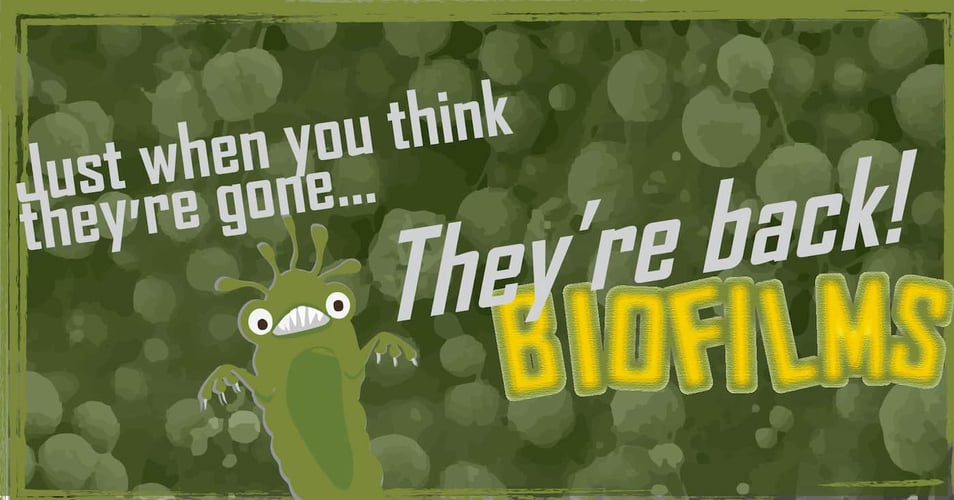Attack of the Killer Slime: It's not a B-Movie, It's a Biofilm

In a previous post, we examined the three things required for bacteria to form a biofilm: Moisture, nutrients, and a surface. Once these biofilms become established, they begin to act in very creepy ways. Today we'll look at some of the characteristics of biofilms that are the stuff of nightmares. Don't say we didn't warn you.
Once individual bacteria adhere to a surface, they begin to secrete a substance that makes it easier for other bacteria to stick to them. The attached bacteria then begin to create a matrix of this sticky substance that still others can attach to and use as an anchor. The lowest layer of bacteria, the layer closest to the surface the biofulm is growing on, can even be considered metabolically dead, as it focuses all its energy on creating the stiky matrix for the benefit of the entire biofilm. With the matrix established, the biofilm continues to grow.
This is where things start to get spooky. Studies show that during the creation of a biofilm, individual pathogen cells can sense their surroundings and communicate with neighboring cells as well as with the biofilm as a whole. This ability is called quorum sensing (quorum = the number of members of a committee). This mysterious ability, thought to be enabled by chains of molecule signals produced by the bacteria cell, allows each cell to sense how many bacteria cells are near them. (This ability appears to be centered on the presence of the tiny hairs, or pilli, that cover the outer membrane of a bacteria cell.) If the bacteria senses a large number of other bacteria, it is more likely to engage in behavior that allows them to adhere to the group. So imagine a zombie wandering the post-apocalyptic streets of NYC alone. His creepy zombie senses pick up recruiting signals emitted from a zombie group inside an abandoned building, so he stops and joins them, sharing in their battles but also in the brains. This is just like the swimming bacteria cell, which happens to float near a biofilm. It senses a large number of fellow bacteria nearby, and moves over to join then, secreting the required glue to attach.
Bacteria in biofilms also use quorum sensing to communicate to the entire group, allowing the biofilm to work together. This communication even works between species of bacteria. In essence, quorum sensing acts as a network that can mobilize millions of bacteria instantly. Let's go back to our recently-recruited zombie. Once he joins the group, he finds his undead brain wired into the collective brain of the group. They all think together now (and isn't that just so much better?) so they can move together and receive specific tasks. In the case of bacteria, the signals can tell the biofilm to move, to specialize into delegated tasks, or form specific shapes to enable spreading.
Wait. Biofilms moving? Attack of the killer slime from the great beyond? This is not an exaggeration - biofilms move. They can ripple across a surface, moving like a huge, flat worm lifting into ridges and then spreading forward. They can use their communication network to form a hard outer wall, enabling the inside bacteria to separate and float over the wall and down to the surface, where they reattach. This movement allows the biofilm to seek more nutrients as well as to send detached segments off to start new biofilms. If you must, you may see some biofilm movement here. The images may haunt you.
Biofilms are a fairly new area of research. Scientists are exploring how the cells differentiate to different tasks, how they ensure that each cell is helping the group, how they communicate, and what genes are responsible. They are also exploring how biofilms may reveal secrets to how life evolved on earth from single cells to complex organisms made up of billions of specialized cells. One of the major research areas is how biofilms contribute to chronic illness in humans, and we will explore that in next week's post.
Editor's Note: This post was originally published in June 2015 and has been updated for freshness, accuracy and comprehensiveness.
![EOScu Logo - Dark - Outlined [07182023]-01](https://blog.eoscu.com/hubfs/Eoscu_June2024/Images/EOScu%20Logo%20-%20Dark%20-%20Outlined%20%5B07182023%5D-01.svg)

![[infographic] Modes of Transmission Download and share!](https://no-cache.hubspot.com/cta/default/216314/interactive-178287789067.png)



